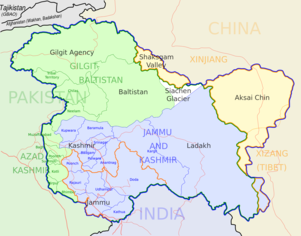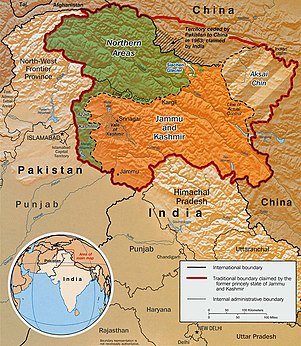


The Actual Ground Position Line (AGPL) divides current positions of Indian and Pakistani military posts and troops along the entire 110 kilometres (68 mi) long frontline in the disputed region of Siachen Glacier.[1][2][3][4] AGPL generally runs along the Saltoro Mountains range, beginning from the northernmost point of the (LOC) at Point NJ 9842 and ending in the north on the Indira Ridge at the India-China-Pakistan LAC tripoint near Sia Kangri about 4 km (2.5 mi) northwest of Indira Col West, with peaks in excess of 7,000 m (23,000 ft) and temperatures ranging to around −55 °C (−67 °F).[5][6] India gained control of 1,000 square miles (2,600 km2) of disputed territory in 1984 because of its military operations in Siachen.[7][8] A cease-fire was announced in 2003.[9][10][11]
India has at least 108 forward military outposts and artillery observation posts in this area where temperature goes down to −86 °C (−123 °F) during winters with icy 300 km/h (190 mph) blizzards.[citation needed]Bana Top (6,200 metres (20,500 ft)) is the highest post and requires an 80-kilometre (50 mi) trek that takes up to 20 days for troops to reach. Pahalwan Post (6,100 metres (20,000 ft)), and Indira Col (5,800 metres (19,000 ft)), are other high posts. India has two major bases, each with a brigade strength of five to eight battalions supported by additional artillery, air defence, engineer and other logistic units: Thoise which serves the southern Siachen sector, and Siachen Base Camp which serves the northern and middle sectors of Siachen.[12] Kumar Post, a logistics subbase of Siachen Base Camp, is a 60-kilometre (37 mi) 9-day return trek from Siachen Base camp towards Indira Col.[13] India has significant tactical advantage as it occupies most of the higher peaks on the Saltoro Mountain Range in the western sector of Siachen. The Pakistani Army hold posts at lower heights on the western slopes of the spurs of the Saltoro Ridge. Pakistan has not been able to scale the crest of the Saltoro Range occupied by India.[12] Each post has an artillery officer who are deployed in the rotation of 45 days.[14] The average temperature is between minus 25°C during day and minus 55°C during the night.[15] As of 2013, Siachen operations cost INR 3,000 crore annually where over 850 Indian and over 1,800 Pakistani soldiers have died, mostly not in combat, but due to the weather conditions.[12]
Till 2013, 26 decorations have been awarded to the Indian soldiers in this sectors, including a Paramvir Chakra (PVC), five Mahavir Chakra and 20 Vir Chakra to 11 officers and 15 OR of which nine are posthumous. Additionally, many more Kirti Chakra, Shaurya Chakra, Sena Medal and Vayu Sena Medal have been awarded in this sectors.[12]
The actual India-Pakistan boundary is divided into four types of borders: disputed Sir Creek (SC) riverine border, mutually agreed India–Pakistan International Border (IB) from north of Sir Creek to north of Dhalan near Jammu, LoC across disputed Kashmir and Ladakh regions from north of Dhalan in India and west of Chicken's Neck in Pakistan to Point NJ9842, and Actual Ground Position Line (AGPL) across Siachen from Point NJ9842 to Indira Col West. Siachen lies south of the Shaksgam ceded by Pakistan to China via the 1963 Sino-Pakistan Agreement but also claimed by India[11] and Aksai Chin held by China since 1962 but also claimed by India. The Shaksgam Tract, controlled by China, is located north of the Saltoro mountain range from the Apsarasas Kangri Range to 90 km (56 mi) northwest of K2.[16]
- ^ The fight for Siachen
- ^ "The endless India-Pakistan sabre-rattling over Siachen glacier and the Line of Control can be resolved by turning the area into a peace park for glacial and weather studies, by B G Verghese, and more from Asian Conversations and Dancing Wolf Media". Archived from the original on 2015-04-12. Retrieved 2015-04-07.
- ^ They shall not pass
- ^ "Bullish on siachen". Archived from the original on 2014-02-22. Retrieved 2014-02-17.
- ^ "Revisiting Siachen after the Ladakh stand-off".
- ^ Cite error: The named reference
controlall1was invoked but never defined (see the help page). - ^ Desmond/Kashmir, Edward W. (31 July 1989). "The Himalayas War at the Top Of the World". Time. Archived from the original on 14 January 2009. Retrieved 11 October 2008.
- ^ Desmond, Edward W. (31 July 1989). "The Himalayas War at the Top Of the World". Time. Archived from the original on 14 January 2009. Retrieved 11 October 2008.
- ^ Watson, Paul (26 November 2003). "India and Pakistan Agree to Cease-Fire in Kashmir". Los Angeles Times. Archived from the original on 27 April 2017. Retrieved 27 April 2017.
- ^ Kapadia, Harish (1999). Across Peaks & Passes in Ladakh, Zanskar & East Karakoram. New Delhi, India: Indus Publishing Company. pp. 94, 185–87. ISBN 81-7387-100-0.
- ^ a b "Pakistan: Signing with the Red Chinese". Time. 15 March 1963. Retrieved 11 January 2020.
- ^ a b c d 30 years of the world’s coldest war, The Tribune, 13 April 1984.
- ^ Siachen Glacier open to tourists! Everything you must know before visiting world’s highest battlefield, Financial Express, 26 October 2019.
- ^ Haryanvi Meghdoot who defended the most challenging post in Siachen, The Tribune, 9 Nov 2019.
- ^ Everyday is a story: Army officers recall their time at Siachen Glacier, Indian Express, 14 Feb 2016.
- ^ R Baghela and M Nüsserab, 2015, Securing the heights: The vertical dimension of the Siachen conflict between India and Pakistan in the Eastern Karakoram, Political Geography (journal), Volume 48, Pages 24–36.